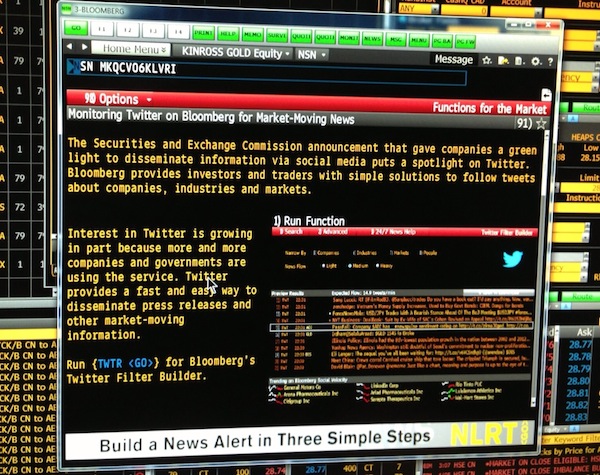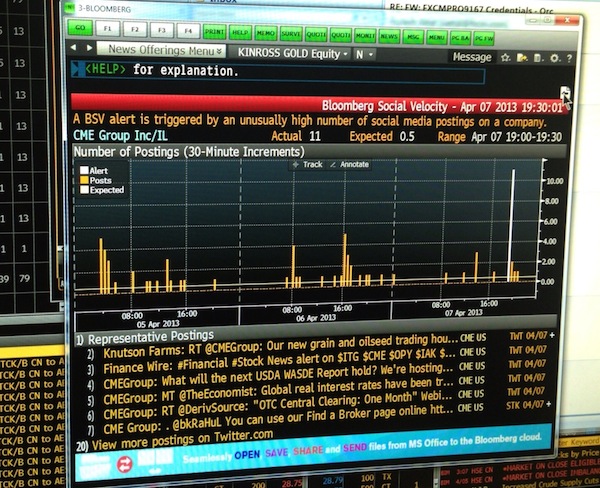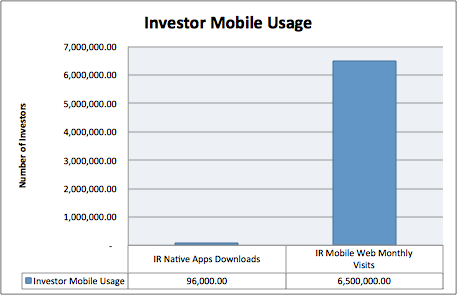![NIRISWRC]() I’ve been travelling a lot lately, back and forth across the country talking about the web, social media, mobile and everything in between. I’ve been fortunate to speak to IR and corporate communication pros and have some great discussions with them about all these trends and best practices.
I’ve been travelling a lot lately, back and forth across the country talking about the web, social media, mobile and everything in between. I’ve been fortunate to speak to IR and corporate communication pros and have some great discussions with them about all these trends and best practices.
Recently I moderated a panel in Fort Worth, Texas for NIRI South West region called Digital Cross Training. The panel consisted of:
- James K. Wicklund, Managing Director, Energy Research, Credit Suisse LLC;
- Vikram Taneja, Associate Director, Orix Ventures; &
- Anne Hedrich, Manager, e-Communications Public and International Affairs, Apache Corporation.
As the panel was set to be 45 minutes we decided to focus on four aspects of the digital landscape:
- Websites
- Twitter
- Linkedin
- Mobile.
The session wasn’t recorded, so I’m going to do my best to recall my introductions to the topics and the key takeaways. I really enjoyed the dynamic on the panel, if I sell it short I hope my fellow panelists chime in to correct me!
1) Corporate Investor Websites
With the rise of social media, there was some discussion that corporate websites would be replaced by things like Facebook. As well, a common theme I hear from some folks in IR is that investors don’t “need” to access websites, and instead that they can get all the information they want from Bloomberg or Yahoo.
With this back drop I put the question to the panel:
Are corporate websites rising in importance or dwindling? What role do they play from an investor perspective?
The answer and discussion that followed was that websites play a critical role in telling the companies story. It’s not just about the normalized data that you can get from Bloomberg or Yahoo, it’s about understanding what the company does, and it’s overall corporate strategy. Content such as presentations, videos of management, operational data, information on products, etc. all contribute to forming a better understanding of the business – and from a long term investor standpoint this is critical.
![Blog3]()
I then referenced Rivel Research’s 2012 that found 65% of the buy-side visit corporate websites at least monthly and asked Vikram and Jim if this echoed their experience with how websites are used. The answer was unequivocally yes. I forget who said this, but it really resonated with me:
“Story matters, context matters, if your corporate website is a filing cabinet its as useful as saying to check you out on Yahoo”
2) Twitter
Today, Twitter is well known to most people. Albeit with a low percentage of adoption, I believe that 18% of Internet users are on Twitter. However, the impact of Twitter in the capital markets seems to just continue to increase. Most recently with Carl Ichan joining Twitter, filing with the SEC about using it for disclosure. The fact that he joined Twitter indicates that Twitter is continuing its rise as the world’s primary information network.
I then asked Jim, about how he uses Twitter, because access to it is blocked at Credit Suisse. His response was very interesting, in that he and others at his firm do not post information to Twitter. Not due to IT restrictions, but rather compliance being the issue. And with Twitter being public anything they put out there could be used against them. However, they do read Twitter and follow smart people on the channel.
This perspective was echoed by Vikram who stated the same, that following smart people on Twitter and Stocktwits is considered a requirement these days. And that waiting for the media to pick up and report on a story simply took too long. If you want to be in the know, you have to use it.
As well, Vikram mentioned that live tweeting earnings calls was very useful. Whether you’re not able to attend the call and follow the tweets live, or being able to go back for key messages, data points, the tweets are very useful.
Apache’s Twitter account has a broad range of information being shared, including financials, corporate responsibility and third party posts. So I then asked Ann: ‘Can you talk about how you use Twitter and it’s value?’
![ApacheTwitter]()
Anne’s perspective (managing social media at Apache Corp) was that Twitter helped her share a broad range of information about the company. Both news and updates from the company and other third party posts. Simply, it allows her to push way more information out to stakeholders than using press releases, which they would naturally limit how many they publish due to cost.
“Using Twitter allows me to share a broad set of information, way more than I ever would using press releases alone”
When I asked the panel: ‘Should companies be using Twitter to communicate with investors?’ The answer was a resounding yes. It simply makes it easier to follow a company if they are using Twitter.
3. LinkedIn & Mobile
The discussion then moved to LinkedIn and Mobile. As there have been a lot of developments on these two topics, I will be doing a separate post to discuss the significant rise in use and impact of LinkedIn and Mobile in the corporate communications and investor world.
I wanted to include in this post, but I’ve run out of time!
I’ll be back. #terminator
 I came across this SlideShare earlier today and I wanted to share it here. It’s quite an indepth presentation that covers all aspects of social media. When you have a few minutes I highly recommend flipping through it. The numbers continue to blow me away, I hope you enjoy it as much as I did.
I came across this SlideShare earlier today and I wanted to share it here. It’s quite an indepth presentation that covers all aspects of social media. When you have a few minutes I highly recommend flipping through it. The numbers continue to blow me away, I hope you enjoy it as much as I did.


 Six years ago a group of us sat around a board room table thinking of what to call this exciting new company we were starting. We wanted something that was short, memorable and captured the spirit of the markets. We came up with Q4 and instantly loved it. The fourth quarter is when you put it all on the line, it’s the big push to close the year on a high note. I love this time of year.
Six years ago a group of us sat around a board room table thinking of what to call this exciting new company we were starting. We wanted something that was short, memorable and captured the spirit of the markets. We came up with Q4 and instantly loved it. The fourth quarter is when you put it all on the line, it’s the big push to close the year on a high note. I love this time of year. There is a general theory of technology adoption know as
There is a general theory of technology adoption know as 





















 We are happy to announce our latest product called
We are happy to announce our latest product called 
 The desktop version of 3 Screens is our market leading IR website platform. It provides complete creative freedom on how the site is structured. Q4’s platform is the most flexible and can support any type of layout or functionality. The benefit of 3 Screens is the desktop IR website is not restricted in any way from the other mobile display options. The desktop IR website includes the following features, plus many more!
The desktop version of 3 Screens is our market leading IR website platform. It provides complete creative freedom on how the site is structured. Q4’s platform is the most flexible and can support any type of layout or functionality. The benefit of 3 Screens is the desktop IR website is not restricted in any way from the other mobile display options. The desktop IR website includes the following features, plus many more! The browser apps included in 3 Screens are designed to work across all types of smart devices and provide an app experience directly inside of the users browser on their tablet or phone. There is no need to download and install an app from an app store. The app is delivered inline, while the user is looking for information. High level features include:
The browser apps included in 3 Screens are designed to work across all types of smart devices and provide an app experience directly inside of the users browser on their tablet or phone. There is no need to download and install an app from an app store. The app is delivered inline, while the user is looking for information. High level features include:








 Yesterday, IR magazine posted “
Yesterday, IR magazine posted “





 I came across a great post on LinkedIn today, shared by
I came across a great post on LinkedIn today, shared by  Back in 2011, I was a part of a group of industry players working together on the message about the NYSE subsidy program and the merits of opening the program up to allow for other vendors to compete and drive innovation.
Back in 2011, I was a part of a group of industry players working together on the message about the NYSE subsidy program and the merits of opening the program up to allow for other vendors to compete and drive innovation. I’ve been travelling a lot lately, back and forth across the country talking about the web, social media, mobile and everything in between. I’ve been fortunate to speak to IR and corporate communication pros and have some great discussions with them about all these trends and best practices.
I’ve been travelling a lot lately, back and forth across the country talking about the web, social media, mobile and everything in between. I’ve been fortunate to speak to IR and corporate communication pros and have some great discussions with them about all these trends and best practices.